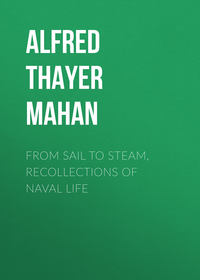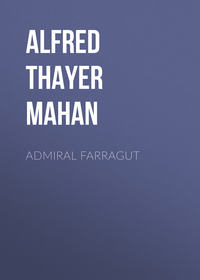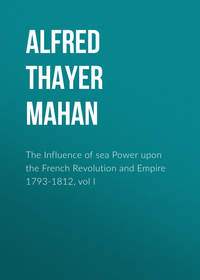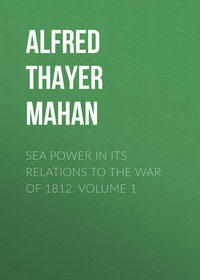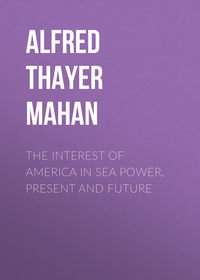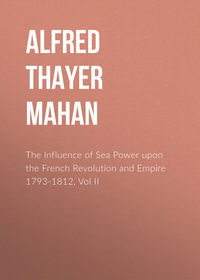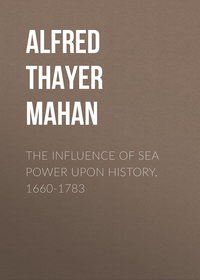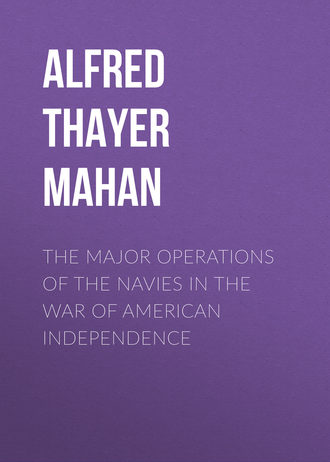 полная версия
полная версияThe Major Operations of the Navies in the War of American Independence
101
"Letters of Lord Hood." Navy Records Society, p. 35.
102
Beatson, "Military and Naval Memoirs," v. 347.
103
Sir John Ross, in his "Life of Saumarez," who was lieutenant in the flagship, says that the flagship only passed ahead of the Buffalo, and that the rear ships closed upon the latter. The version in the text rests upon the detailed and circumstantial statements of another lieutenant of the squadron, in Ekins's "Naval Battles." As Ekins also was present as a midshipman, this gives, as it were, the confirmation of two witnesses.
104
James Saumarez, Lord de Saumarez, G.C.B. Born, 1757. Commander, 1781. Captain, 1782. Captain of Russell in Rodney's action, 1782. Knighted for capture of frigate Réunion, 1793. Captain of Orion in Bridport's action, at St. Vincent, and at the Nile (when he was second in command). Rear-Admiral and Baronet, 1801. Defeated French and Spaniards off Cadiz, July 12th, 1801. Vice-Admiral, 1805. Vice-Admiral of England and a peer, 1831. Died, 1836.
105
Ante, p. 183.
106
Probably Prudent, 64. There was no President in the fleet.
107
The times and general movements are put together from Hood's Journal and the Log of the Canada, published by the Navy Records Society. "Letters of Lord Hood," pp. 64, 86.
108
When ships were in order of battle, or column, close to the wind, if they all tacked at the same time they would still be ranged on the same line but steering at an angle to it, on the opposite tack. This formation was called bow and quarter line, because each vessel had a comrade off its bow—to one side and ahead—and one off its quarter—to one side but astern. The advantage of this, if heading towards the enemy, was that by tacking again together they would be at once again in column, or line ahead, the customary order of battle.
109
Illustrations of other phases of this battle can be found in Mahan's "Influence of Sea Power upon History," pp. 470, 472.
110
White, "Naval Researches."
111
Sharp up by the starboard braces, the wind being on the starboard quarter. This emptied the aftersails of wind, neutralizing their effect, and, by causing the ship to move more slowly, kept her longer abreast an anchored opponent.
112
White, "Naval Researches."
113
Ante, p. 164.
114
Seven hundred and twenty feet. For ships of the line of that day this would make the interval between each two about four ships' length. At five knots speed this distance would be covered in something over a minute.
115
Probably not over one or two hundred yards from the enemy.
116
The position, in the French order, of the ships taken in the battle, is shown by the crosses in Positions 4, 5, 6.
117
Canada's log, 8.15; reduced to Hood's times, which are generally followed.
118
Ante, p. 200 (note).
119
This mishap occurred to three French vessels.
120
Ross, "Life of Saumarez," i. 71.
121
Circular pieces of wood which cap the top of the masts.
122
Letters of Lord Hood, p. 103. Navy Records Society.
123
Mundy, "Life of Rodney," ii. 234.
124
She is thus rated in the British Navy Lists published between the time of her capture and the receipt of news of her loss; but she seems to have carried 120 guns.
125
Letters of Lord Hood, pp. 103, 104.
126
See letter of Sir Howard Douglas, son to Sir Charles; "United Service Journal," 1834, Part II, p. 97.
127
Author's italics; Mundy, "Life of Rodney," ii. 248.
128
Author's italics; Mundy, "Life of Rodney," ii. 248.
129
Troude. Chevalier says sixteen, differing with. Troude as to the whereabouts of the Brave.
130
Letters of Lord Hood, p. 136.
131
Letters of Lord Hood, p. 134.
132
Ibid., p. 104.
133
That is, with a great part of her guns dismounted, and below as cargo.
134
Chevalier, following La Motte-Picquet's report, ascribes Howe's escape to greater speed. ("Mar. Fran. en 1778," p. 335.) It must be noted that Howe's object was not merely to escape eastward, up Channel, by better sailing, but to get to the westward, past the allies, a feat impracticable save by a stratagem such as is mentioned.
135
Chevalier, "Mar. Fran, dans la Guerre de 1778," p. 358.
136
Now Mauritius.
137
On the Malabar—western—coast.
138
See ante, p. 163.
139
I infer, from the accounts, that the Monmouth was well east of the Hero, that the French had passed her first, and that the Héros was now on her port beam; but this point is not certain.
140
Expressions in Johnstone's Report.
141
Charnock, however, says that in 1762, immediately after receiving his post-commission, he commanded in succession the Hind, 20, and the Wager, 20. Moreover, before his appointment to the expedition of 1781, he had been Commodore on the Lisbon Station. But he had spent comparatively little time at sea as a captain.—W.L.C.
142
See ante, pp. 79, 80.
143
One being the captured British Hannibal, 50, which was commissioned by Captain Morard de Galles, retaining the English form of the name, Hannibal, to distinguish her from the Annibal, 74, already in the squadron.
144
In the plan, Positions II and III, the second position is indicated by ships with broken outlines. These show the two lines of battle in the engagement until the wind shifted to south-south-east. The results of the shift constituted a third position, consecutive with the second, and is indicated by ships in full outline.
145
Previously the British East Indiaman, Elizabeth.
146
Forty-five degrees.




